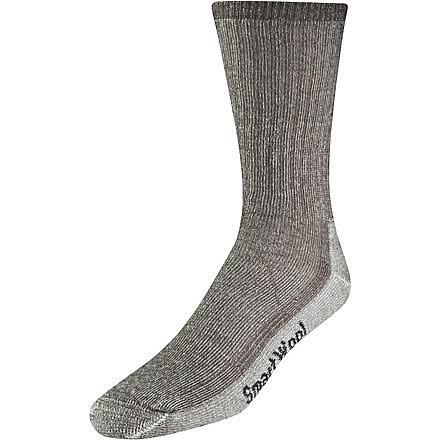Blisters often curse a hiking trip, even those trips that are just a few miles over flat terrain. During a hike, a small, tiny blister often grows into a swollen, painful menace—resulting in a miserable hiking trip as the hiker limps awkwardly home.
 |
| Bighorn Sheep Don't Have to Worry About Blisters |
Preventing blisters requires both well-fitted hiking boots and the use of quality hiking socks.
It does no-good to hike in a $300 pair of boots while wearing a cotton sock. And it does no-good to hike in a poor-fitting boot while wearing the best hiking sock available. Avoiding blisters starts with using a well-fitting boot and a dedicated hiking sock.
To help hikers in Montana (and elsewhere) enjoy blister-free hikes, I’ve put together this article based on my own hard-earned experience in past battles with blisters.
This article covers the following topics:
The Importance of the Hiking Sock
While I lack data to prove my suspicions, I strongly suspect the leading cause of blisters among hikers is from the use of poor fitting or simply the "wrong type" of sock. Before examining methods to adjust hiking boots to avoid blisters, it is crucial that a hiker uses the right sock. After all, it is the sock—not the boot—that lies against the skin. And it is the rubbing of the sock against the skin that causes blisters.
Say No to Cotton Socks
Rule #1 when it comes to socks for hiking is to always wear dedicated hiking socks. Never use cotton socks. Period.
Using cotton socks for hiking is so bad that hikers have a better chance to avoid blisters by not using socks at all than by wearing a cotton sock. Yes, cotton socks are THAT bad.
Why are cotton socks so terrible? Cotton socks are awful for hiking because they quickly get wet (cotton holds and absorbs sweat), bunch up inside the boot and then rub against the hikers skin. Remember, the sock rubbing against the skin is what causes blisters. Dedicated hiking socks, such as those made by Smartwool, Thorlos & Wigwam, substantially reduce or eliminate this problem.
The Many Benefits of Hiking Socks
First, dedicated hiking socks provide significant additional padding for the feet—particularly in high impact areas (such as the heel, ball of the foot, and the top of the foot below where the boot is laced). This padding, besides helping prevent blisters, also significantly increases comfort and alleviates the “sore foot” problem often encountered on longer hikes or hikes through rocky terrain.
Second, dedicated hiking socks are made from various natural (Smartwool) or synthetic (Thorlos & Wigwam) materials that do NOT absorb water. Instead, hiking socks transfer water from the foot into the fabric of the boot (where it will then dissipate if the boot is a quality breathable hiking boot). In short, a dedicated hiking sock keeps the hikers foot dry by letting the foot breathe. And a dry foot is a necessity for blister-free hiking.
 |
| A SmartWool Hiking Sock. A Hiker's Best Friend. |
Finally, hiking socks are thicker and much stronger than cotton socks. Even the thinnest hiking socks will not “bunch up” inside the hiking boot (with cotton socks, having the sock “bunch up” by the toes is a common problem and often leads to nasty blisters not easily treated along the trail).
My favorite hiking socks are made by Smartwool, Thorlo and Wigwam. I use these socks for all hikes, whether short or long, and regardless of terrain. Made from premium merino wool, Smartwool socks are very comfortable and quite soft. By contrast, Thorlo and Wigwam socks are synthetic creations—but work just as well for hiking.
Hiking socks are not inexpensive, as they average between $10-$20 a pair, depending on the sock’s thickness. But they are worth every penny spent.
So which brand to get? And what’s really the difference between them? A detailed review about these three different types of hiking socks is covered in another article on this website—the Hiking Sock Guide.
For a quick summary, Smartwool socks are by far the softest socks and the most “snuggly.” However, Smartwool socks lack the durability found in Wigwam and Thorlo socks since merino wool isn’t the most durable of fabrics on the planet.
For general summer weather hiking, my personal preference is to use thinner synthetic hiking socks from Thorlos or Wigwam, as I find the thinner synthetic socks are more durable than thinner Smartwool hiking socks. For colder weather, I use the medium-weight or heavy-weight Smartwool socks since they are so warm and soft and work just as well for "indoor use" as they do for outdoor hiking.
Smartwool, Thorlo and Wigwam socks are widely available online. In particular, Amazon almost always has the full selection of styles and sizes in-stock.
Other online retailers that usually sell many, but not necessarily all, styles of these socks includeEastern Mountain Sports, Campsaver, REI and other online outdoor retailers that sell quality technical gear.
Breaking In a Boot & Proper Lacing
All hiking boots or hiking shoes need a break-in period. How long the break-in period lasts depends on what the boot/shoe is made from. The older but still widely used leather hiking boots are notorious for lengthy break-in periods, since the leather needs to stretch to better conform to the hikers foot.
Yes, even the breathable, fabric hiking boots and shoes need a break-in period. The break-in period isn’t nearly as long, but still exists.
Because of the need for a break-in period, to avoid blisters hikers should avoid going out on long, rugged hikes in new boots. For leather boots, take many, many shorter hikes on level to moderate terrain—while packing along some moleskins just in case. For fabric hiking boots and hiking shoes, simply walking around town for a few hours is all that’s needed to break in new boots.
Once a boot is broken in, next comes the need to properly lace a boot. A boot not laced tight enough allows the foot to squirm around inside the boot, creating hot spots and blisters. However, a hiker needs to avoid over-tightening the boot. A boot too tightly laced causes the foot to swell, leading to many painful and unpleasant sensations.
Because of this, a hiker needs to experiment with various degrees of tightness to find the “sweet spot.” Also, remember that the tightness often needs to be adjusted while out hiking, too.
Rescuing A Hiking Boot Using Inserts
Preventing blisters requires a proper fitting boot. A poor fitting boot is a recipe for blisters. However, if the boot fits almost fine but causes some hot spots (where the skin gets hot due to the boot rubbing it) on uphill/downhill climbs, a cure for this is to use hiking boot inserts. Hiking boot inserts go inside the boot and remove some (and sometimes all) of the dead space that causes a hiker's foot to move around in the boot.
I did this with my favorite hiking boots and it worked remarkably well. On steep, uphill climbs, I felt hot spots form on my heel, leading to small blisters over the course of long walks unless covered up by moleskins. Using inserts removed the hot spots (although I did have to loosen how tightly the boots were laced).
Thus, a hiker who owns a boot that fits well shouldn’t throw them away just because of the occasional blister—especially if the blisters form when walking up or downhill. Instead, the hiker should customize them with an insert. Often, using an insert will solve all blister problems.
Hiking inserts are widely available online. Amazon, as usual, carries a wide selection of hiking boot inserts.
Other online retailers that sell dedicated hiking boot inserts include REI, Eastern Mountain Sports, Campsaver and most other online retailers that sell quality outdoor gear.
Lose Weight...Gain Blisters
It’s a sad fact of life. A person’s foot can change sizes even long after a person left their teenage years behind. In particular, a change in weight often causes a noticeable change in the size/shape of the foot—especially the width. For example, someone who loses 50 pounds often discover their boots become quite loose due to the loss of fat. While the change in foot size is small compared to elsewhere on the body, remember that even small changes in the size/shape of the foot lead to dramatic differences in how well a boot fits. When fitting a hiking boot, it is a battle of “millimeters.”
If a person has had a big weight change (whether up or down), it is entirely possible that their favorite pair of boots might be “beyond salvage.” While using boot inserts sometimes can help, often times significant weight loss simply shrinks the foot so much that even boot inserts can’t rescue a boot.
Because of this, individuals who have lost significant weight shouldn’t waste money or time trying to rescue an old pair of boots. Instead, they should celebrate their weight loss by buying a new pair of boots that fits their newly shrunken foot.
Moleskins - A Hiker's Best Friend
Despite their odd name, moleskins are a hiker’s best friend and should be part of any hikers pack. Moleskins, for those not familiar with them, are bandages for blisters. Moleskins—when properly used—cover hot spots or blisters on the foot, thus preventing the sock/boot from rubbing against the skin and further inflaming a blister.
Ideally, the “How to Use Moleskins” method is to apply them to the skin whenever a hiker feels a hot spot developing and long before a full-fledged blister develops. Indeed, many frequent hikers apply moleskins on “frequent hot spots” before the hike even begins—thus preventing any blister problems from happening while on the trail.
All hikers should carry moleskins on all but the shortest hikes. Moleskins are inexpensive and can make the difference between a happy hike and a miserable outing.
Moleskins are widely available online and off. Most pharmacies such as Walgreens sell them. However, for the price paid for moleskins at Walgreens, hikers can pick up a Blister First Aid Kit. These kits contain not just the moleskins, but also usually include scissors, tape and a small carry pouch for around $10. These blister first aid kits are available at Amazon.
View Blister First Aid Kits at Amazon
